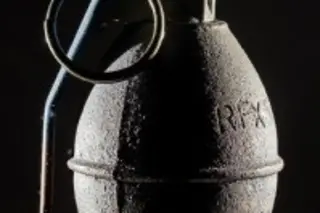Photo: flickr/Martin TaylorWhat makes for a good grenade? Well, how far and accurately you can throw it, how easy it is to throw, and how it feels to throw it seem like pretty good measures. And how do you know which shape of grenade is best? Why, by throwing lots and lots of hand grenades. At a flagpole. Laugh all you want, but if you are ever in a situation requiring the use of a hand grenade, you're probably going to want its designer to have read this type of research. Influence of hand grenade weight, shape and diameter on performance and subjective handling properties in relations to ergonomic design considerations. "Three hand-grenade design factors, namely shape (ball, oval, can), diameter (55, 60, and 65 mm) and weight (300, 400, and 500 g), were assessed. The objective criteria were (1) throwing distance from the grenade stop point to throwing point, ...
Designing ergonomic hand grenades.
Discover essential hand grenade design factors that impact throwing distance, accuracy, and ergonomic performance for optimal results.
More on Discover
Stay Curious
SubscribeTo The Magazine
Save up to 40% off the cover price when you subscribe to Discover magazine.
Subscribe













